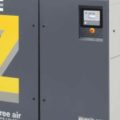Hey! This site is reader-supported and we earn commissions if you purchase products from retailers after clicking on a link from our site.
Within the air compressor industry, acronyms are found in abundance, especially when it comes to measuring airflow. The most common ones are SCFM and ACFM, with ICFM coming right after them. In order to understand these, you must first understand CFM, cubic feet per minute, which is the general measurement for the amount of air that a compressor provides.
If you require a refresher or more information on CFM, visit our What Is CFM and What Does CFM Mean on An Air Compressor guide. This article will focus on providing you with all the relevant information on SCFM, ACFM & ICFM, as well as presenting how to calculate and convert each value.
Table of Contents
- What is SCFM?
- What is ACFM?
- What is the Difference Between ACFM & SCFM
- What is ICFM?
- Calculating & Converting SCFM, ACFM & ICFM
- SCFM, ACFM, or ICFM
- FAQs (Frequently Asked Questions)
What is SCFM?
SCFM, standard cubic feet per minute, is a standard measurement of air output that takes atmospheric conditions into account. The SCFM of an air compressor is a specific set of parameters determined by ASME (the American Society of Mechanical Engineers) and is recognized not only in the compressed air industry but in many others.
The SCFM calculation is based on standard atmospheric conditions in order to measure the mass flow of air coming from an air compressor. The standard conditions include:
- atmospheric pressure of 14.696 PSIA
- relative humidity of 36%
- ambient temperature of 68°F
It is possible to calculate the maximum SCFM output of an air compressor by using these conditions. Essentially, SCFM is the one and only way to compare air compressors across the industry. To learn ways in which you can increase CFM, visit our guide!
What is ACFM?
The ACFM, or actual cubic feet per minute, typically has different definitions depending on the industry which can cause a lot of confusion. Within, the air compressor industry, ACFM is the true air mass flow given during a set of specific real-life conditions.
It can be seen as a measurement of CFM based on the actual output of air in a certain environment. And so, it can be quite tricky because surrounding environments and atmospheric conditions impact it, and so the ACFM of a compressor will vary in different locations.
For instance, an air compressor situated high above sea level compared to one at sea level will have a significantly lower output due to the ambient conditions so high up.
What is the Difference Between ACFM & SCFM
At standard air conditions, where there are no efficiency losses, SCFM and ACFM are equal to one another. Where the inlet conditions vary from the standard conditions, consideration must be taken to ensure that the specified air compressor has enough power to generate adequate air mass flow for optimum performance of the connected pneumatic tool.
ACFM will typically be a higher number than SCFM if any of the following conditions are different from the standard conditions listed further up this page:
- atmospheric pressure is lower (greater elevation from sea level)
- humidity is higher
- temperature is higher
A good way to think about this is that a compressor needs to work harder the further it drifts away from standard conditions. Therefore, a more powerful air compressor with a higher SCFM rating would be required to generate the desired ACFM for the air tool to perform effectively.
Here are some quick calculations that can be used as a guideline:
- For every 1000 ft, or 305m, of elevation above sea level (standard condition), ACFM demand increases by approx. 5%
- For every 20% of humidity increase over 36% (standard conditions), ACFM demand increases by approximately .5%.
- For every 20°F (11.1°C) of ambient temperature increase over 68°F (standard conditions), ACFM demand increases by approximately 5%.
What is ICFM?
ICFM, inlet cubic feet per minute, identifies the flow rate at the inlet of an air compressor after the inlet filter, blower, or booster. As air passes through these components, there will typically be pressure drop or rise, if there wasn’t then the ICFM and ACFM values would be the same.
The greater the difference in pressure and temperature through the components, the greater the difference between ICFM and ACFM.
Calculating & Converting SCFM, ACFM & ICFM
When it comes to calculating, or converting these values, it can be done by following the process below. SCFM of air compressors is provided to you already when you purchase an air compressor, typically referred to as the CFM output of the compressor. Visit our SCFM vs CFM guide for more information!
If you wish to calculate the ACFM, you can convert the SCFM value using the following formula:
ACFM = SCFM x [Pstd / (Pact – Psat Φ)] x (Tact / Tsat)
Where:
ACFM = actual cubic feet per minute
SCFM = standard cubic feet per minute
Ptsd = standard absolute pressure (psia)
Pact = absolute pressure at actual level (psia)
Psat = saturation pressure at actual temperature (psi)
Φ = actual relative humidity
Tact = actual ambient air temperature (oR)
Tsat = standard temperature (oR)
To then calculate ICFM, you must convert ACFM using the following formula:
ICFM = ACFM x (Pact / Pf) x (Tf / Tact)
Where:
ICFM = inlet cubic feet per minute
Pf = pressure after filter or inlet equipment (psia)
Tf = temperature after filter or inlet equipment (oR)
When it comes to the temperatures in both sets of equations, they’re standard temperatures in oR. So, for example, at a temperature of 50oF, you would implement 510oR (50 + 460).
SCFM, ACFM, or ICFM
The most difficult tasks is sizing a compressor properly, or specifying the compressor’s reduced capacity. It is thereby important to note that the proper understanding of these terms will help when selecting a compressor. SCFM should be used to compare the differences in compressors capacities, ACFM for actual non-standard site conditions and proper load applications while, ICFM should be used when a filter, booster or blower is added into the system.
At higher altitudes, you must account for the decrease in pressure when estimating a compressor’s performance. Sometimes nlowers or boosters are used for economic reasons but they are not always the best option to use. Therefore, when tighter controls are employed, ACFM should not be used to determine a compressors capacity, ICFM should be.
FAQs (Frequently Asked Questions)
ICFM is calculated by multiplying the ACFM (actual ) by the absolute pressure at actual level (psia) divided by pressure after filter or inlet equipment (psia) and then multiplied again by the temperature after filter or inlet equipment (oR) divided by the actual ambient air temperature (oR).
ACFM is only the same as SCFM if the compressor is under standard conditions and there are no efficiency losses. The standard conditions include atmospheric pressure at sea-level of 14.696 PSIA, relative humidity of 36%, and an ambient temperature of 68°F (19°C).
The key difference between SCFM and CFM is that SCFM measures the CFM of a compressor based on ideal, or standard, conditions. While CFM is a measure of the actual flow rate. CFM is typically the recognized value across the United States for measuring air flow.
To convert SCFM to ACFM you must multiply SCFM by the standard absolute pressure (psia) divided by the absolute pressure at actual level (psia) minus the saturation pressure at actual temperature (psi) multiplied by actual relative humidity. And then, multiply this by the actual ambient air temperature (oR) divided by standard temperature (oR).
Additional CFM reading:
- Best Ways to Increase CFM On Air Compressors
- Connecting Two Air Compressors Together
- How to Calculate CFM of Air Compressors
- CFM Pipe Size Chart
- SCFM vs CFM for Air Tools & Air Compressors Guide to Compressor Ratings
- What Is CFM and What Does CFM Mean on An Air Compressor?
- Air Compressor Size For Spraying Stucco & Plaster
- Does a die grinder require low or high CFM?
- Speedaire 4B247 swapped with 2Z499 and its effect on CFM?
- 20 CFM Air Compressor – Buying, Hiring, What Can They Run?
- Air Compressors That Produce 500 CFM And Above
- CFM SCFM PSI Compressor Flow Issues
- Ingersoll Rand Type 30 model 242 HP and CFM?
- CFM rating of Black Max compressor
What size air compressor:
- What Size Air Compressor Do I Need? How to Size An Air Compressor
- What Size Air Compressor Do I Need For Impact Wrench?
- What Size Air Compressor For Sander?
- What Size Air Compressor For Sandblasting?
- What Size Air Compressor For Framing Nailer?
- What Size Air Compressor For Air Hammer?
- What Size Air Compressor For Air Ratchet?
- What Size Air Compressor for Car Detailing?
- What Size Air Compressor for Truck Tires?
- What Size Air Compressor For Nail Gun
- What Size Air Compressor for Painting Cars?
- What Size Air Compressor Do I Need for Spray Painting?
- What Size Air Compressor For Staple Gun Or Upholstery Air Stapler?
- What Size Air Compressor For Sandblasting?
- What Size Air Compressor Do I Need For A Die Grinder?
If you have any questions regarding SCFM vs ACFM vs ICFM and their differences, please leave a comment below, with a photo if applicable, so that someone can help you!





